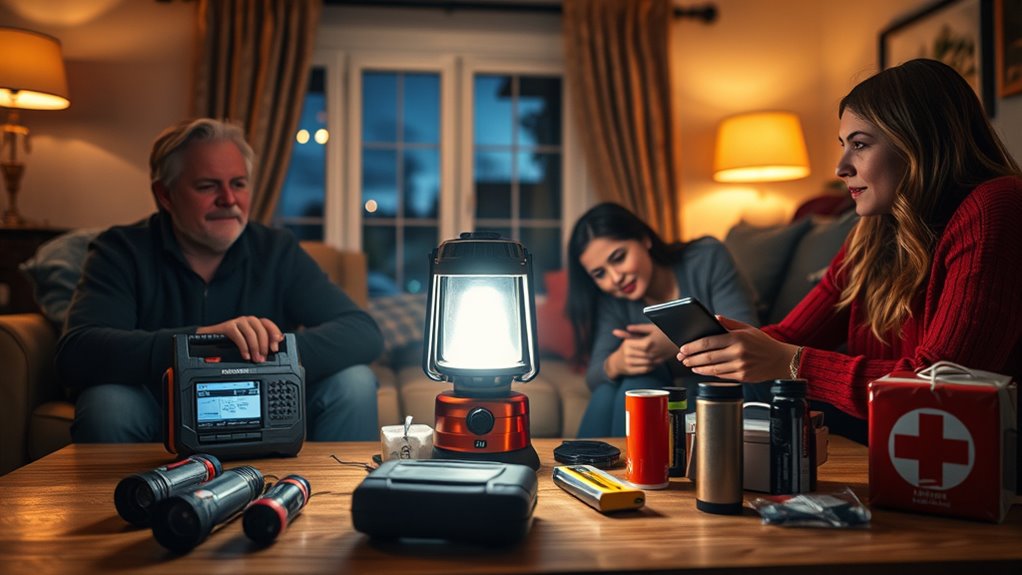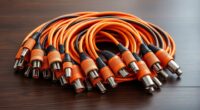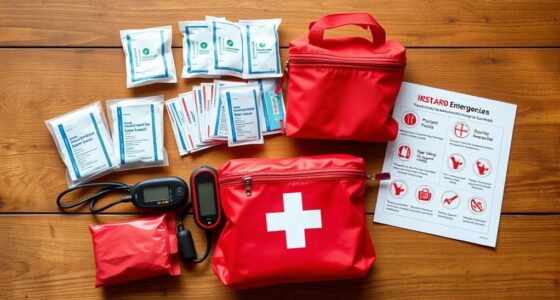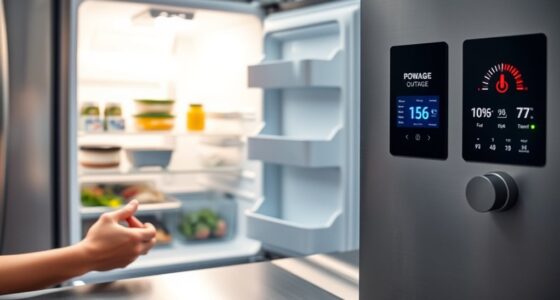During outages, carbon monoxide (CO) risks increase because it’s an invisible, odorless gas produced by generators, heaters, or faulty appliances. To stay safe, always operate generators outdoors far from vents and windows, and never inside your home or garage. Install CO detectors on every level and near sleeping areas, test them regularly, and replace batteries each year. If you suspect CO poisoning, get outside immediately and seek emergency help. Continuing to learn these safety tips can protect you and your loved ones.
Key Takeaways
- Use generators outside at least 20 feet away from your home to prevent deadly carbon monoxide buildup.
- Never run fuel-powered appliances or heaters indoors or in enclosed areas during outages.
- Ensure proper ventilation by opening windows and vents when using any fuel-burning device.
- Install CO detectors on every level of your home, especially near sleeping areas, and test them monthly.
- If you experience symptoms like headache or dizziness, leave the area immediately, get fresh air, and call emergency services.
What Is Carbon Monoxide and Why Is It Dangerous?
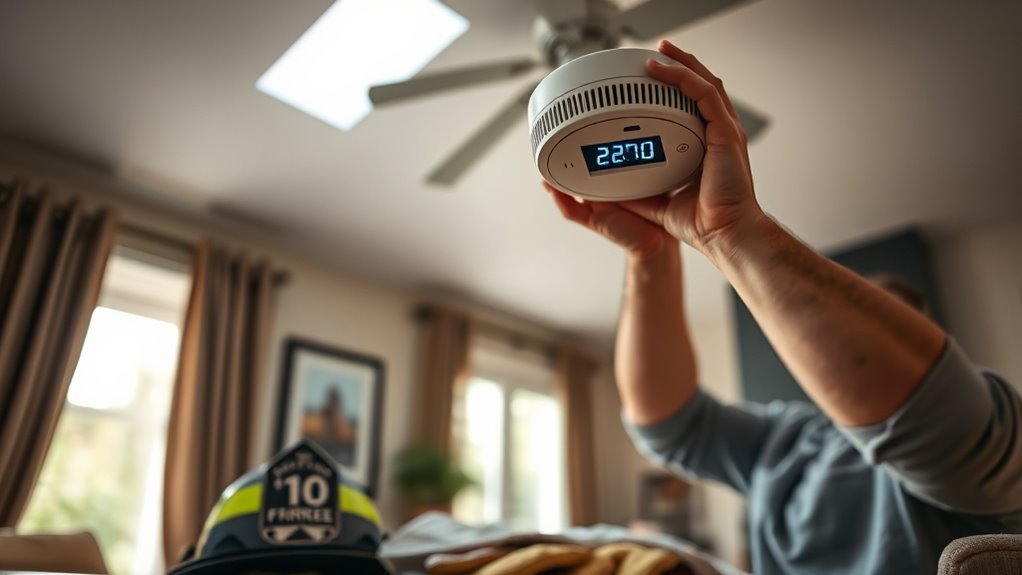
What exactly is carbon monoxide, and why should you be concerned about it? Carbon monoxide (CO) is a colorless, odorless gas that can build up indoors without you noticing. It’s produced by burning fuels like gas, wood, or charcoal, especially when appliances are faulty or poorly ventilated. Poor indoor air quality caused by CO can lead to serious health issues, including headaches, dizziness, nausea, or even death in high amounts. That’s why CO safety laws are in place—to protect you from these dangers. During outages, appliances might operate improperly or inefficiently, increasing the risk of CO buildup. Knowing what CO is and understanding the importance of indoor air quality helps you stay safe, especially when power failures occur. Hackathons can be a useful platform for developing innovative solutions to monitor and improve indoor air quality and CO safety.
How Outages Increase the Risk of CO Poisoning
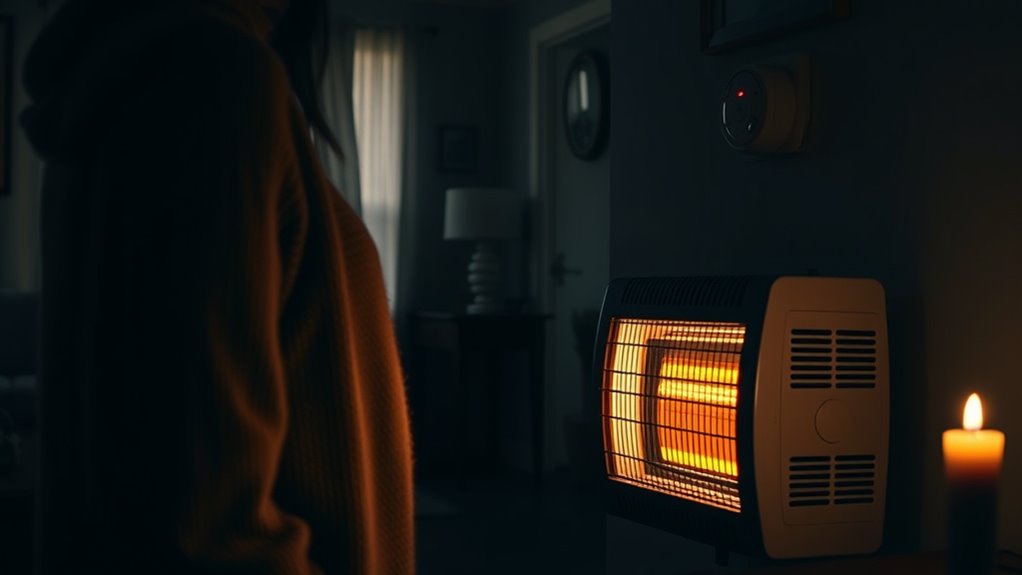
During outages, limited ventilation can cause harmful CO fumes to build up quickly. Using portable heaters or unattended fuel devices increases the risk of carbon monoxide poisoning if they’re not monitored carefully. Being aware of these hazards helps you stay safe during power outages. Additionally, ensuring proper ventilation can significantly reduce the danger of CO buildup in enclosed spaces.
Limited Ventilation Risks
When power outages block proper ventilation, the risk of carbon monoxide (CO) buildup skyrockets. Without a functioning ventilation system, fresh air can’t flow in, and stale, potentially hazardous air can’t escape. Limited airflow management leads to a confined space where CO can quickly accumulate from appliances like generators, space heaters, or other fuel-burning devices. You might not notice the dangerous buildup until symptoms appear, which is why maintaining adequate ventilation is critical. During outages, avoid sealing off rooms or using enclosed spaces that trap air. Keep vents clear and open windows when possible. Proper airflow management ensures fresh air enters and exhausts harmful gases, reducing the likelihood of CO poisoning in your home during power outages. Forsale 100
Use of Portable Heaters
Portable heaters become especially risky during power outages because many rely on fuel sources like propane, kerosene, or natural gas, which can produce deadly carbon monoxide if not used properly. To stay safe during portable heating, keep these tips in mind:
- Always operate heaters in well-ventilated areas to prevent CO buildup.
- Never use outdoor heaters indoors—fumes can accumulate quickly.
- Regularly check for proper ventilation and maintain heater safety by following manufacturer instructions.
- Be aware that electric bikes and other battery-powered devices should be used cautiously during outages to avoid potential safety hazards.
Using portable heating devices responsibly reduces the risk of CO poisoning. Remember, even small leaks or improper use can lead to dangerous levels of carbon monoxide. Prioritize heater safety, and never compromise ventilation or operation guidelines during outages. Stay alert and keep your household safe.
Unattended Fuel Devices
Have you considered how unattended fuel-powered devices can increase the risk of carbon monoxide poisoning during power outages? When you leave fuel storage or unattended devices like generators running, CO can build up quickly indoors or in poorly ventilated spaces. These devices produce deadly gases if not monitored carefully. Proper filtration and pump protection on your equipment can help prevent malfunctions that might contribute to unsafe emissions.
| Fuel Storage Tips | Safe Use of Unattended Devices |
|---|---|
| Store fuel outside | Never leave generators running unattended |
| Keep fuel containers sealed | Ensure proper ventilation during operation |
| Regularly check for leaks | Turn off devices when not in use |
Leaving fuel or unattended devices running can trap CO in your home, especially when ventilation is limited. Always monitor fuel-powered devices closely to prevent dangerous CO buildup during outages.
Recognizing the Symptoms of CO Poisoning
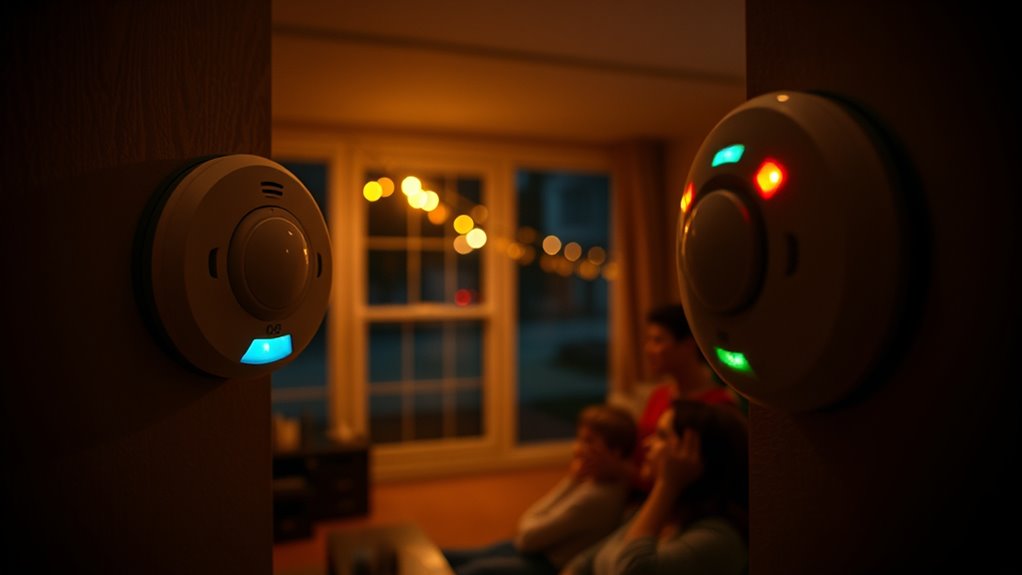
How can you tell if you’re experiencing carbon monoxide poisoning? Recognizing the symptoms early is crucial for symptoms awareness and early detection. CO poisoning often mimics flu-like symptoms but without a fever. Pay close attention if you notice:
- Headaches that won’t go away
- Dizziness or weakness, especially during an outage
- Nausea or vomiting, combined with confusion or blurred vision
If these symptoms appear, leave the area immediately and get fresh air. Prompt action can prevent serious health issues. Remember, CO is odorless and invisible, so trusting your symptoms is key. Being aware of these signs helps protect you and your loved ones from dangerous exposure during outages. Always prioritize early detection and seek medical help if needed. Additionally, having a reliable air purifier with proper filtration can help reduce indoor pollutants and improve safety during outages.
Proper Use of Generators During Power Outages

When using a generator during a power outage, make sure to place it outdoors away from windows and vents. Proper ventilation is essential to prevent dangerous CO buildup inside your home. Always follow safety guidelines to reduce the risk of carbon monoxide poisoning. Additionally, ensure your generator has proper grounding to prevent electrical hazards.
Safe Generator Placement
Proper generator placement is crucial for your safety during power outages. To prevent dangerous carbon monoxide buildup, you must place your generator outdoors, away from windows and vents. Here are three essential tips:
- Keep the generator at least 20 feet from your home, ensuring proper outdoor safety.
- Avoid placing it near electrical wiring, vents, or open windows to prevent CO fumes from entering your house.
- Use a sturdy, flat surface to prevent movement and secure it from rain or moisture.
- Always check your generator’s safety instructions to ensure proper placement and operation.
Always follow manufacturer instructions on placement, and never operate a generator indoors or in enclosed spaces. Proper outdoor safety and electrical wiring awareness protect you and your loved ones from CO poisoning and other hazards during power outages.
Proper Ventilation Needed
To guarantee safe operation of your generator during power outages, adequate ventilation is essential. Proper ventilation essentials ensure indoor airflow stays clear of dangerous fumes, preventing buildup of carbon monoxide. Always operate your generator outdoors in a well-ventilated area, never inside garages, basements, or enclosed spaces. Good airflow helps disperse exhaust gases and keeps air safe to breathe. Use this quick guide to remember key ventilation tips:
| Ventilation Tip | Why It Matters | Best Practice |
|---|---|---|
| Place generator outdoors | Ensures proper exhaust dispersal | Keep a distance from windows/vents |
| Maintain clear airflow | Prevents fumes from accumulating | Avoid blocking ventilation paths |
| Use in open areas | Reduces risk of buildup | Stay upwind of your generator |
Proper indoor airflow and ventilation essentials keep everyone safe during outages.
Avoid Carbon Monoxide Risks
Using a generator improperly can quickly lead to dangerous carbon monoxide buildup, which poses serious health risks. To avoid this, follow these safety tips:
- Never run the generator indoors or in enclosed spaces—outdoor activities require proper placement away from windows and vents.
- Keep household appliances and generators at least 20 feet apart, with the wind blowing fumes away from your home.
- Use a carbon monoxide detector nearby to alert you if CO levels become unsafe during outdoor activities or generator use.
Safe Placement of CO Detectors in Your Home
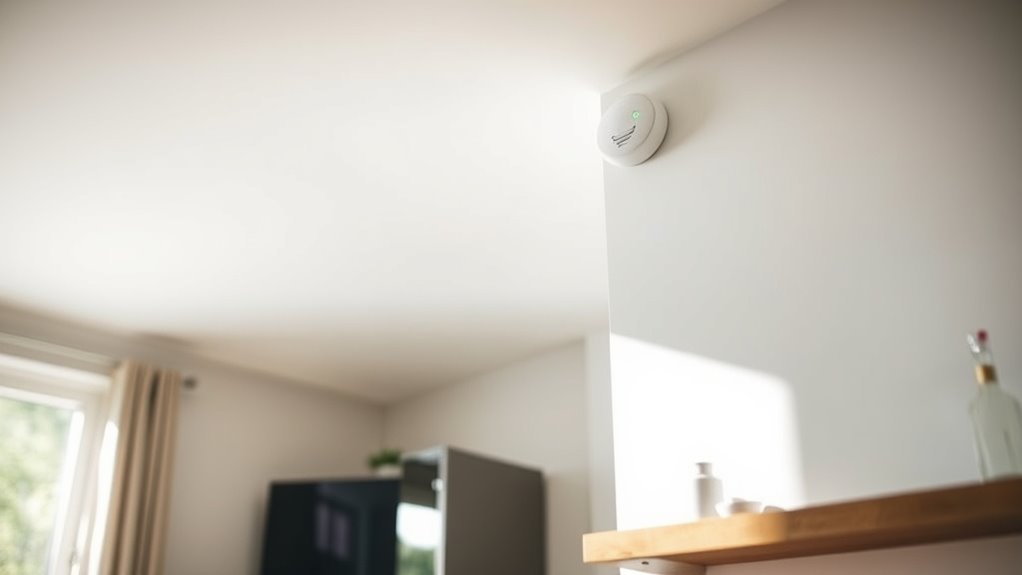
Because carbon monoxide is odorless and can quickly build up indoors, placing CO detectors in the right locations is essential for your safety. Proper CO detector placement guarantees you can detect the gas early, before it reaches dangerous levels. Place detectors on every level of your home, especially near sleeping areas, to wake you if CO is present during the night. Keep detectors at least 15 feet away from fuel-burning appliances to prevent false alarms caused by normal appliance operation. Choose locations with good airflow and avoid placing detectors in dead spots, which could reduce their sensitivity. Remember, the placement affects the detector’s sensitivity; correct positioning ensures you get timely alerts, protecting you and your loved ones from CO poisoning. Ensuring proper placement can also help prevent false alarms caused by environmental factors.
Maintenance and Testing of CO Detectors
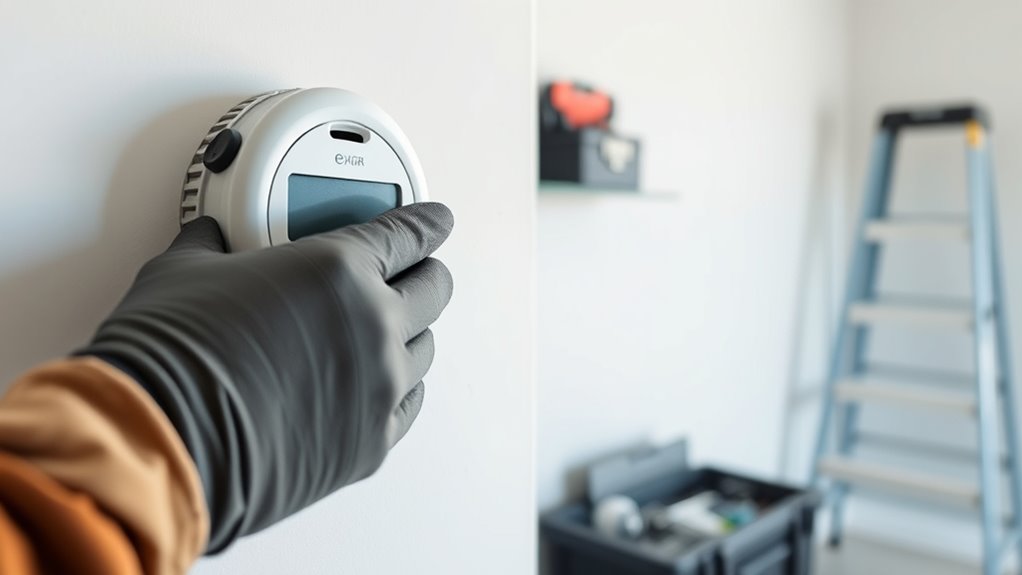
Regular maintenance and testing are essential to guarantee your CO detectors work properly when you need them most. Following carbon monoxide regulations ensures your safety, and proper detector maintenance is key to compliance. To keep your detectors reliable, remember these three steps:
- Test your detector monthly by pressing the test button to ensure it’s functioning correctly.
- Replace batteries at least once a year or when the low-battery warning sounds.
- Replace the entire unit every 5-7 years, as sensors can degrade over time.
- Stay informed about Free Crypto Opportunities that can help fund safety upgrades for your home detection systems.
Tips for Preventing CO Build-Up Indoors

Properly maintaining your CO detectors is essential, but taking steps to prevent carbon monoxide from accumulating in your home can make an even bigger difference. Improve indoor air quality by ensuring appliances like furnaces, water heaters, and stoves are regularly inspected and properly vented. Never ignore CO safety myths, such as believing open windows alone prevent CO buildup; these are false and can be dangerous. Use exhaust fans when cooking or running appliances that produce combustion gases. Keep vents clear of debris and ensure outdoor vents aren’t blocked. Avoid running generators or other fuel-burning equipment indoors or in enclosed spaces. By staying proactive and informed, you minimize the risk of CO buildup, keeping your home safer during outages and everyday situations.
What to Do If You Suspect CO Exposure
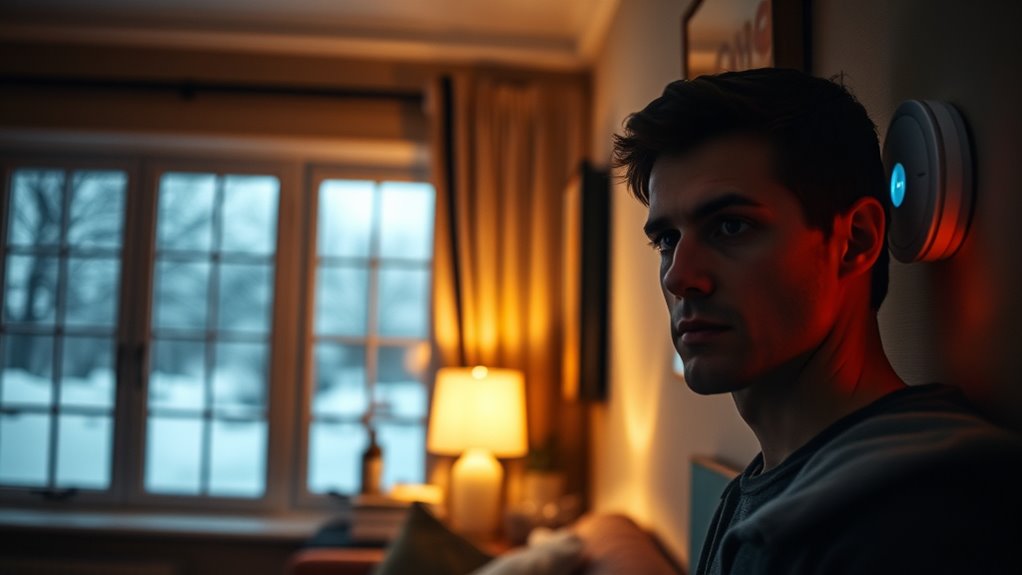
If you suspect someone has been exposed to carbon monoxide, act immediately to protect their health. Do not ignore common carbon monoxide myths that downplay the danger. Instead, focus on preserving indoor air quality and getting help fast. Here are essential steps:
- Get everyone outside into fresh air immediately. Carbon monoxide is odorless and deadly indoors.
- Call emergency services without delay. Professional help is essential for proper diagnosis and treatment.
- Avoid re-entering the building until authorities confirm it’s safe. Don’t rely on false beliefs about CO exposure; symptoms can be subtle. Prioritize safety and remember, proper ventilation is important but not enough if CO levels are high. Acting quickly can prevent serious health consequences.
Emergency Response and When to Call for Help

When you recognize signs of carbon monoxide exposure or suspect a problem, acting quickly with an emergency response can save lives. First, open windows and use ventilation techniques to help disperse the gas temporarily. Turn off any appliances or devices that may be producing CO, if safe to do so. Call emergency services immediately—don’t wait. Your emergency preparedness means knowing when to seek professional help and staying calm. Make sure everyone evacuates the area and remains outside until trained responders declare it safe. Keep a clear path for emergency personnel. Remember, prompt action and proper ventilation techniques are crucial in minimizing risk. Calling for help without delay can prevent serious injury and ensure everyone stays safe during a CO emergency.
Frequently Asked Questions
How Long Does It Take for CO Poisoning Symptoms to Appear?
Symptoms of CO poisoning can appear within minutes to a few hours after exposure, depending on the concentration and duration. You might notice headache, dizziness, or nausea quickly, sometimes within 6-8 hours of exposure. The poisoning timeline varies, but rapid symptom onset is common with higher levels of CO. If you suspect CO exposure, act immediately, get fresh air, and seek emergency help to prevent serious health consequences.
Can CO Buildup Occur Outdoors During Outages?
Outdoor CO buildup can happen during outages if you run a generator improperly, such as too close to your home or in poorly ventilated spaces. Always guarantee generator safety by operating it outdoors, away from windows, doors, and vents. Never run a generator indoors or in enclosed areas, as CO can accumulate outdoors if ventilation is inadequate. Proper placement and ventilation help prevent dangerous outdoor CO buildup during outages.
Are There Specific Safety Guidelines for Portable Heaters?
Portable heater safety is like walking a tightrope—you need balance and awareness. Always follow manufacturer instructions, guarantee proper maintenance tips, and keep heaters away from flammable materials. Use carbon monoxide detectors, never leave heaters unattended, and keep vents clear. These safety guidelines help prevent risks, especially during outages. Regular maintenance tips, like checking for gas leaks or damaged cords, keep you safe while staying warm.
How Can I Tell if My CO Detector Is Functioning Properly?
You can tell if your CO detector is working properly by regularly performing detector maintenance and testing procedures. Press the test button on your detector to verify it sounds the alarm, and replace the batteries if needed. Also, check the detector’s expiration date and replace it every 5 to 7 years. Consistent testing and maintenance help ensure your detector functions correctly and keeps you safe from carbon monoxide risks.
What Are COmmon Sources of CO Leaks in Homes?
Common sources of CO leaks in homes include appliance malfunctions like gas furnaces, water heaters, and stoves that aren’t working properly. Ventilation issues can also trap carbon monoxide, especially if vents are blocked or poorly installed. Be sure to regularly maintain appliances, keep vents clear, and install detectors to catch leaks early. If you suspect a CO leak, leave your home immediately and call emergency services.
Conclusion
By staying aware of CO risks and properly using detectors, you create a safe environment—like installing a smoke alarm just as a fire starts. During outages, your careful generator placement and maintenance act as the shield that keeps danger at bay. When you recognize symptoms early and respond swiftly, you’re like the steady lighthouse guiding loved ones away from hidden hazards. Safety isn’t just a coincidence; it’s a habit that keeps everyone protected.
